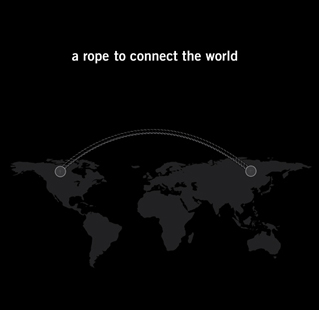The Longest Rope
to Connect the World
By Lining Yao, Sayamindu Dasgupta, Nadia Cheng, Jason Spingarn-Koff, Ostap Rudakevych, Hiroshi Ishii from Tangible Media Group, MIT Media Lab and Harvard Graduate School of Design (Contact: liningy@media.mit.edu )
 |
 |
Tangible and Gestural Rope Games For Remote Play
How to play rope jumping and kite flying remotely with your new friends?
How to add some humor and physical activities to remote conferencing?
How to create the co-present feeling while playing rope games remotely?
Rope Revolution, a rope-based gaming system for collaborative play. After identifying popular rope games and activities around the world, we developed a generalized tangible rope interface that includes a compact motion-sensing and force-feedback module that can be used for a variety of rope-based games, such as rope jumping,kite flying, horse riding, etc. Rope Revolution is designed to foster both co-located and remote collaborative experiences by using actual rope to connect players in physical activities across virtual spaces.
|
|
|
 |
|
|
A: Kite Flying
A virtual kite shows up on the screen, serving as an extension of the real rope controlled by the player. The player releases the rope to allow the kite to be lifted higher; the rope remains in the same location if the player does not interact with the rope; and it falls downward if the rope is pulled.
|
 |
B: Horse Riding
A player can select the horse-driving game at the game-selection stage by whipping the rope up and down for several seconds. For this game, the scene transitions to a long, curved rode. The game's objective is for the player to keep the horse on the road while traveling.
|
|
C: Rope Jumping
The jump-rope game can be played either by a singer player or by two players remotely. In the remote multi-player mode, one person acts as the rope-twirler while another person is the rope-jumper. The jumper's space can have a pressure sensor pad to detect the player's jumping. |
 |
D: Wood Sawing
During the game, trees can be sawed by pulling and releasing the rope. The score in this game depends on how quickly players can saw and successfully cut a tree down.
|
|
|
 |
|
|
Software Interface
The whole software was built in Java. We developed several gestural patterns built into our rope gesture library. Later on, if players play a certain gesture related pattern, their motion can also be sensed using a corresponding algorithm. With the Wiimote as our sensing mechanism, Wiigee library [21] was used as a basis to perform gesture recognition and motion sensing. |
 |
Rope Gesture Recognition
Motion sensing during the game play was achieved by a combination of the data analysis from both the 2-axis potentiometer inside the box module (for games such as kiteflying, in which the rope needs to be reeled in and released) and the 3-axis accelerometers from the handle module. The data can be sent to a computer via Bluetooth. For remote players, computers from different locations can communicate over the internet.
|

|
 |

|
|
|
 |
|
|
Hardware
The core hardware is the rope module, which includes a force feedback and potentiometer-based motion sensing mechanisms on the mounted end, and a accelerometer-based motion sensing mechanism at the user's end
|
 |
Force Feedback and Motion Sensing Box
The force feedback box that is fixed to the wall houses a constant-force spring that controls the rope's direction into and out of the wall and a linear actuator that controls the rope's direction along the width of the wall.
Gesture Recognizing and Motion Sensing Handle
The handle at the user's end of the rope has two main functions: gestural recognition and motion sensing. Both of the functions rely on a 3-axis accelerometer, which communicates with a computer via Bluetooth.
|

|
|
|
 |
|
|
Future Work: Rope Games to Connect the World
One important goal of this work is to build a vocabulary for discussing rope interfaces used in collaborative play experience. To explore the scope of rope's physical affordances based on
people's real world experiences.
|
 |
Design Space
We have separated the design space into five main layers: targets, scenarios, interactions, interfaces and add-ons.
|
|
Publications
CHI 2011 Alt-chi Paper: RopePlus: bridging distances with social and kinesthetic rope games
CHI 2011 wip Paper: Multi-jump: jump roping over distances
|
|
About us
It's a going on project mainly in the MIT Media Lab. It was initialized in a Tangible Interface class given by professor Hiroshi Ishii from the Tangible Media Group, MIT Media Lab. We are open to the idea of installing the system for certain exhibitions with certain financial support.
Questions and suggestions can be sent to : liningy@media.mit.edu
High resolution pictures can be downloaded here: link |












